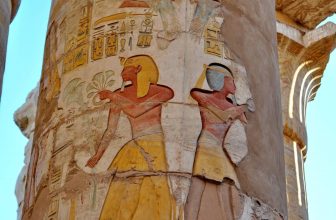The church of Saint Sergius is situated to the north of the Coptic Museum, down a narrow cobbled lane, and lies some three meters below street level. The church is dedicated to two Roman officers, Sergius and Bacchus, who were martyred in Syria in 303. The earliest part of the building dates from the fifth century and was built over the cave where, according to tradition, the Holy Family hid during their Flight into Egypt. The structure was burnt down and restored in the eighth century.
The whole of the church was again restored and partially rebuilt during the Fatimid era (tenth to twelfth centuries). Despite restoration and reconstruction, the church of Saint Sergius is nevertheless regarded as a model of the early churches in which Copts worshiped.

The entrance is approached down a flight of stairs. It leads to the side of the narthex, where there is a large plunge-bath, boarded over. At the end of the narthex is the baptistery. The nave of the church, which has an arched timber roof, is separated from the side aisles by marble pillars. The figures that once decorated the columns are only dimly discernible today. On the right -hand wall is a Biblia Pauperum that includes such commemorative occasions as Christ’s birth, miracles, baptism, and resurrection; it dates to medieval times. Also in the church is an interesting thirteenth-century carving of the Last Supper. Jesus sits with his disciples at a table, which is of similar shape to an ancient Egyptian offering table. Indeed, a Coptic altar closely resembles such an offering table. It has a raised molding with a break in the border to drain off water.

The marble pulpit in the nave, which rests on ten columns, is a modern copy of the pulpit in the church of Saint Barbara. Fragments of the original rosewood pulpit, inlaid with ebony and ivory, are now preserved in the Coptic Museum. The sanctuary screen is decorated with several panels which may originally have come from the leaves of a door .the upper part contains small panels of ebony set with large crosses of solid ivory, exquisitely chiseled with scrollwork. Lower down, the ivory is set in arabesque shapes. The icons are of the twelve apostles, with the virgin at the center.
Brass oil lamps hang from the ceiling, and two steps lead up to the sanctuary and the side chapels’.the original canopied altar is one of the treasures of the old wing of the Coptic museum. The central apse wall is encrusted with marble and decorated with mosaics. Parts of the original paintings can still be seen in the dome. the side chapels contain numerous icons including one of the flight into Egypt, where Mary shown on a mule is wearing a crown and holding Jesus followed by Joseph and Mary Magdalene the crypt, where the holy family is believed to have hidden during the flight into Egypt, lies to the left of the sanctuary. The original cave was situated beneath the center of the transept. It was turned into a three-aisled chapel; with an altar in the wall in the form of a tomb-recess. a commemorative mass is celebrated in the church of Saint Sergius on June 1, which the Copts believe to be the day of the flight. Despite the current restoration of this famous church, visitors are allowed to see the crypt.














